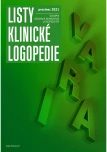THE EFFECT OF EQUINE-FACILITATED INTERVENTION ON THE DEVELOPMENT OF COMMUNICATION SKILLS IN CHILDREN WITH NEURODEVELOPMENTAL DISORDERS
Authors:
Jónová Viola 1; Janatová Markéta 2; Hovorková Lucie 3; Svobodová Xenia 4
Published in:
Listy klinické logopedie 2021; 5(2): 30-36
Category:
Miscellaneous
Overview
Equine-facilitated intervention encompasses activities and therapies in areas where the horse and the person with health or social disadvantages or special needs meet. The intervention may focus on motor, psychological, social or educational areas, depending on the individual client’s equine-facilitated intervention goals. By combining Speech Therapy and equine-facilitated intervention, a comprehensive intervention is provided for the client with impaired communication skills, by utilising horses, ponies and related activities. The equine-facilitated intervention can be individual or group, and some equine-facilitated intervention programmes also involve family members and caregivers. In studies of the effect of equine-facilitated intervention on children with neurodevelopmental disorders, positive effects of equine-facilitated intervention have been observed on attention, hyperactivity, vocabulary development, social interaction, communication, facilitation of eye contact and improved language skills, in addition to motor function. With the appropriate choice of intervention goals and methods, equine-facilitated intervention can promote improvement in clients’ condition to the extent of their functional potential and thus enhance quality of their life.
Keywords:
Neurodevelopmental disorders – speech therapy – Equine-facilitated intervention
Sources
- ANGOULES, A. G. et al., 2015. A review of efficacy of hippotherapy for the treatment of musculoskeletal disorders. Journal of Advances in Medicine and Medical Research [online]. S. 289-297 [cit. 30. 9. 2021]. Dostupné z: https://www.journaljammr.com/index.php/ JAMMR/article/download/14151/25994
- CHARRY-SÁNCHEZ, J. D., PRADILLA, I., TALERO-GUTIÉRREZ, C., 2018. Animal-assisted therapy in adults: A systematic review. Complementary therapies in clinical practice [online]. 32, s. 169-180 [cit. 30. 9. 2021]. Dostupné z: https://www.sciencedirect.com/ science/article/abs/pii/S1744388118302214?via%3Dihub
- ČERVENKOVÁ, B., 2020. Raná intervence u předčasně narozených dětí s rizikem rozvoje dětské mozkové obrny. Listy klinické logopedie [online]. 4(1), s. 32-36 [cit. 30. 9. 2021]. DOI: 10.36833/lkl.2020.006. Dostupné z: https://logoped.actavia.cz/contents/lkl/2020/01.pdf Česká hiporehabilitační společnost, 2009 [online]. Praha: ČHS [cit. 28. 10. 2021]. Dostupné z: https://hiporehabilitace-cr.com/
- HOAGWOOD, K. E. et al. 2017. Animal-assisted therapies for youth with or at risk for mental health problems: A systematic review. Applied developmental science [online]. 21(1), s. 1-13 [cit. 30. 9. 2021]. Dostupné z: https://www.ncbi.nlm.nih.gov/pmc/articles/ PMC5546745/
- HOLUBOVÁ, A. et al., 2018. Využití digitálních technologií v terapii pacientů po cévní mozkové příhodě. Listy klinické logopedie [online]. 2(2), 32-36 [cit. 30. 9. 2021]. Dostupné z: https://casopis.aklcr.cz/contents/lkl/2018/02.pdf
- KULICHOVÁ, J. et al., 1995. Hiporehabilitace. Praha: Nadace OF.
- LECHTA, V., 2008. Symptomatické poruchy řeči u dětí Vyd. 2., Praha: Portál. ISBN 978-80-7367-433-5.
- MACAULEY, B. 2021. Speech Therapy with Hippotherapy. In: Book of Abstracts –European Conference in Equine Facilitated Therapy. Praha: Czech Equine Facilitated Therapy Association (CEFTA), 2021, s. 78. ISBN 978-80-213-3103-7.
- MARESCA, G. et al., 2020. Hippotherapy in neurodevelopmental disorders: a narrative review focusing on cognitive and behavioral outcomes. Applied Neuropsychology: Child [online]. s. 1-8 [cit. 30. 9. 2021]. Dostupné z: https://europepmc.org/article/med/33949903
- MIŠKOVSKÁ, K. et al., 2020. A case study of the application of hippotherapy in school-age children with multiple disabilities. Zdravotníctvo a sociálna práca [online]. 4, s. 174-178 [cit. 30. 9. 2021]. Dostupné z: https://www.zdravotnictvoasocialnapraca.sk/wp-content/uploads/ ZaSP_Cislo_4_2020_SK-CZ_EN.pdf
- OREL, M., PACOVÁ, V., 2010. Člověk, jeho smysly a svět. Praha: Grada. ISBN 978-80-247-2946-6.
- PAVLŮ, D., 2003. Speciální fyzioterapeutické koncepty a metody I.: koncepty a metody spočívající převážně na neurofyziologické bázi. 2., opr. vyd., Brno: CERM. ISBN 80-7204-312-9.
- RUEG, J. C., 2020. Mozek, duše a tělo: neurobiologie psychosomatiky a psychoterapie, Praha: Portál. 978-80-262-1581-3.
- ŠIMANOVSKÝ, Z., 2007. Hry s hudbou a techniky muzikoterapie ve výchově, sociální práci a klinické praxi, Praha: Portál. ISBN 978-80-7367-339-0.
Labels
Clinical speech therapy General practitioner for children and adolescentsArticle was published in
Clinical speech therapy (Listy klinické logopedie)

2021 Issue 2
Most read in this issue
- SOCIAL-EMOTIONAL PROBLEMS OF CHILDREN WITH DEVELOPMENTAL LANGUAGE DISORDER
- “TEST POROZUMĚNÍ VĚTÁM” – CZECH VERSION WITH STANDARDS FOR ADULTS
- EVALUATION OF LEVEL OF UNDERSTANDING IN CHILDREN FROM EARLY AGE UP TO 3 YEARS OF AGE
- TELEREHABILITATION: CURRENT DEVELOPMENT IN THE CZECH REPUBLIC
